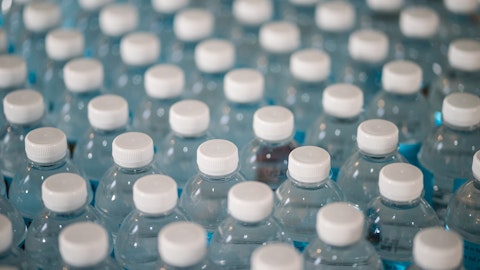Carlisle Companies Incorporated (NYSE:CSL) Q4 2022 Earnings Call Transcript February 7, 2023
Operator: Good afternoon. My name is Hannah, and I will be your conference operator today. At this time, I would like to welcome everyone to the Carlisle Companies Fourth Quarter 2022 Earnings Conference Call. All lines have been placed on mute to prevent any background noise. After the speakers’ remarks, we will conduct a question-and-answer session. I would now like to turn the call over to Mr. Jim Giannakouros, Carlisle’s Vice President of Investor Relations. Jim, please go ahead.
Jim Giannakouros: Thank you. Good afternoon, everyone, and welcome to Carlisle’s fourth quarter 2022 earnings conference call. We released our fourth quarter financial results after the market closed today, and you can find both our press release and earnings call slide presentation in the Investor Relations section of our website, carlisle.com. On the call with me today are Chris Koch, Chair, President and Chief Executive Officer; Kevin Zdimal, our Chief Financial Officer; and Dave Smith, Carlisle’s Vice President of Sustainability. Today’s call will begin with Chris giving an update on our progress in achieving our strategic plan, Vision 2025, highlights of our fourth quarter and full year results and a discussion of our current business outlook.
With our recently announced commitment to achieving Net-Zero emissions by 2050, Dave will elaborate on our commitment to this pledge and provide a general update on our sustainability progress. And Kevin will discuss additional financial details and our outlook for 2023. Following our prepared remarks, we will open up the line for questions. But before we begin, please refer to Slide 2 of our presentation, where we note that comments today will include forward-looking statements based on current expectations. Actual results could differ materially from these statements due to a number of risks and uncertainties, which are discussed in our press release and SEC filings. As Carlisle provides non-GAAP financial information, we’ve provided reconciliations between GAAP and non-GAAP measures in our press release and in the appendix of our presentation materials, which are available on our website.
With that, I will turn the call over to Chris.
Chris Koch: Thank you, Jim. Good afternoon, everyone, and thank you for joining us on our fourth quarter 2022 earnings call. Please turn to Slide 3. Let me begin my commentary by complementing the entire Carlisle team on the sales and earnings records set in the fourth quarter and the full year of 2022. 2022 truly was an exceptional year. In addition to delivering record fourth quarter sales of $1.5 billion, we also delivered record annual sales of $6.6 billion, surpassing both the $5 billion and $6 billion marks in sales for the first time in Carlisle’s 105-year history. We further delivered a record adjusted diluted EPS of $3.92 in the quarter, an increase of 34% year-over-year. 2022 also marked a key milestone in our Vision 2025 journey as we delivered $17.58 of GAAP EPS for the year, exceeding our primary Vision 2025 goal of generating $15 of GAAP EPS for our shareholders.
Exceeding this goal three years early is a testament to the hard work and dedication of all of Carlisle’s employees and to their commitment to the work of Vision 2025. These record results are even more remarkable given the extremely challenging operating environment of the past few years. Of the many challenges we faced over this period, I would say navigating the COVID pandemic was the most unexpected challenge. For so many people, the pandemic was a traumatic experience in their lives from a health and welfare, social and economic perspective. I’m grateful for the significant actions Carlisle employees took to keep us all as safe as possible while navigating COVID in their personal life as well. In addition, we also experienced significant supply chain disruptions and inflationary environment and labor and material shortages.
Our record results would not have been possible without the clarity of mission that Vision 2025 has provided us since its launch in 2018, and the unwavering commitment of our teams. Guided by Vision 2025, our teams remained unified and stayed the course for the past five years, diligently overcoming the challenges we faced. Please turn to Slide 4. Our record results continue to demonstrate that Vision 2025 has been the right strategy for Carlisle. In addition to our world-class teams and proven business model, we’ve benefited from a strong balance sheet, an excellent cash flow generation to provide both financial and strategic flexibility to execute and achieve our ambitious goals. A significant portion of our success has been driven by the multiyear process of reshaping our portfolio to pivot from a diversified industrial products company to a higher returning building products portfolio of businesses.
This transformation sets the stage for a more focused, simplified and better understood path for future sustainable value creation at Carlisle. The pillars of Vision 2025 remain core to our strategy going forward. These include: first, drive mid-single-digit organic revenue growth. In the fourth quarter, we delivered 6.6% organic revenue growth, which helped drive organic growth of 29% for the full year 2022. Notably, all four segments contributed to this growth. Second, utilize the Carlisle Operating System, or COS, to drive continuous improvement. We use COS to consistently drive efficiencies and enhance operating leverage. For the full year 2022, adjusted EBITDA margin expanded nicely and COS contributed to that. We continue to target COS savings of 1% to 2% of annual sales.
Third, build scale with synergistic accretive acquisitions. Under Vision 2025, we have streamlined and optimized our portfolio through acquisitions and divestitures to build scale in our highest returning building products businesses and to broaden our suite of energy-efficient solutions. Through 2022, we have invested over $3 billion in accretive acquisitions. And fourth, a returns-focused capital allocation strategy that includes deploying over $3 billion into capital expenditures, share repurchases and dividends. Since the launch of Vision 2025, we have invested over $3 billion into these areas of capital allocation, also three years ahead of our original plan. In 2022, we made capital investments of over $184 million into our businesses to drive innovation, increase operational efficiencies and enhance the Carlisle experience.
We also returned over $500 million to shareholders with share repurchases totaling $400 million and $134 million paid in dividends in 2022. And of course, none of this would be possible without continuing to invest in and develop exceptional talent. Through the accelerated execution of Vision 2025, Carlisle has built a solid foundation, leveraging a diversified workplace, decentralized management style, entrepreneurial spirit and a culture of continuous improvement, which will continue to guide our value creation journey in 2023 and beyond. Turning to Slide 5. I’d like to highlight some of the many accomplishments in the fourth quarter. First, collectively, our building products segment now constituting over 80% of Carlisle total sales delivered record fourth quarter sales and adjusted EBITDA.
Second, we are pleased with the ongoing integration efforts at our newest segment, CWT. The team continues to effectively capture the projected synergies from the Henry acquisition of $30 million, while focusing on delivering excellent customer service in a challenging environment. This commitment to our channel partners and customers was recognized when Henry was awarded to Home Depot’s Building Materials Vendor of the Year Award in October. Third, we continued the introduction of our innovative labor-saving 16-foot TPO product to the market, which is manufactured on the industry’s latest and most technologically advanced TPO line in Carlisle, Pennsylvania. As a reminder, we began shipping this product in the third quarter of 2022. Additionally, construction of our state-of-the-art polyiso facility in Sikeston, Missouri is on track for completion in the second quarter and on track to achieve LEED Platinum certification, the highest level of commercial building energy-efficient standards.
Fourth, pricing remained and continues to be positive across all segments as we continue to demonstrate our value to our customers. Fifth, supply chain and material availability returned to a more normal state. This return to normal has enabled our channel partners to settle back into more of a historical buying cadence. And finally, global aerospace markets continue their recovery, driving strong sales and backlogs at CIT and increased profitability on the back of the significant restructuring actions taken by the CIT team over the past few years. And with that, I’ll turn it over to Dave Smith, our Vice President of Sustainability, for an update on our ESG progress. Dave?

Dave Smith: Thanks, Chris, and good afternoon, everyone. Please turn to Slide 6. I’d like to begin by reiterating that Carlisle has had a century-long legacy of responsible stewardship and stakeholder focus, all driven by our core cultural value of continuous improvement. We believe that creating a more sustainable environment is also productive for our shareholders. As an organization, Carlisle is committed to being a responsible environmental stakeholder with our three pillars of environmental sustainability. First, develop energy-efficient products and solutions to reduce the greenhouse gas, or GHG emissions, from building operations and help lower operating costs for our customers. In 2022, Carlisle sold $3.5 billion of LEED certified products and solutions, up from $2.5 billion in 2021.
Second, reduced material weights going into landfills. Our history of recycling began in the 1920s when we incorporated scrap rubber into our inner-tube production. Today, we continue that tradition by upcycling polyiso waste into water filtration products. Carlisle has had a century long commitment to reduce material waste and continually improve our processes to deliver shareholder value while improving the environment for the communities in which we operate. And third, a focus on lowering the GHG emissions of our operations and manufacturing processes with the implementation of enhanced energy conservation measures such as converting our factory forklift fleet from propane to electric. During the fourth quarter of 2022, Carlisle probably took a significant step to achieving Net-Zero GHG emissions in our value chain by 2050.
To accomplish this Net-Zero state, we proposed near-term GHG reduction targets through the science-based targets initiative. The site-based targets initiative is an independent body based in the U.K. that works in conjunction with United Nations to help guide companies to establish emission reductions initiatives using science-based targets. Our near-term 2030 GHG reduction targets are: first, to reduce scope 1 and scope 2 emissions by 38%; and second, reduce scope 3 GHG emissions by 48% per pound produced. While our focus on emissions, waste reduction and sustainable products are a key part of our sustainability efforts, we also made a significant commitment to the social component of our ESG progress. On October 17, 2022, we proudly announced a special stock option grant to all eligible U.S. employees and a cash award to all eligible employees outside the U.S. These awards are designed to allow all Carlisle employees to participate in Carlisle’s success as stakeholders.
Previous grants issued in 2009 and 2018, generated significant returns for our employees based in no small part on their contribution to increasing shareholder value. Additionally, our path to zero program, which represents Carlisle’s commitment to creating the safest possible work environment, continues to be a source of pride for our organization. In 2022, Carlisle’s OSHA Incident Rate was a remarkable 0.67, significantly below the industry average of over 3 and that represents a 69% decline in workplace incidents since 2014. And with that, I’ll turn it over to Kevin to provide additional financial details as well as our 2023 outlook. Kevin?
Kevin Zdimal: Thank you, Dave. Before turning to segment results, let’s turn to our overall 2022 fourth quarter results on Slide 7. The fourth quarter played out much as we anticipated and communicated on our last earnings call. As Chris mentioned, the Carlisle team delivered a very strong fourth quarter despite the many challenges we faced. Fourth quarter revenues increased 6.6% organically, driven primarily by positive pricing across all segments. Fourth quarter adjusted EBITDA margin improved 280 basis points, driven by efficiencies gained through COS and our ability to price to value. Revenues, adjusted EBITDA and EPS were all fourth quarter records for Carlisle. For segment highlights, please turn to Slide 8. CCM delivered revenues of $800 million, up 3% organically.
This performance was driven by positive price more than offsetting year-over-year volume declines given current normalization of buying patterns by our customers in severe weather in December in much of the U.S. Adjusted EBITDA margin of 28.5%, a record performance in the fourth quarter by our CCM team was driven by price and COS and partially offset by raw material and labor inflation unfavorable mix and a reduction in volume. Moving to Slide 9. Sales at Carlisle Weatherproofing Technologies increased 5.5% organically. This growth was achieved despite ongoing supply constraints and softness in residential demand. Adjusted EBITDA margin was 12.8%. The team continues to focus on the integration of Henry, the $30 million of stated synergies from the acquisition and rolling out COS throughout CWT to drive greater efficiencies in our operations.
Moving to Slide 10. CIT revenue increased 22% organically in the fourth quarter of 2022 with balanced growth in our commercial aerospace and medical technology platforms. We continue to see domestic travel approach pre-pandemic levels, strong backlogs and growth in our medical new product pipeline. As a result, CIT is well positioned for continued revenue growth and EBITDA margin expansion in 2023. Turning to CFT on Slide 11. CFT generated organic revenue growth of 11.3%, driven by positive pricing and favorable volume, partially offset by a 7% year-over-year foreign exchange headwind. Adjusted EBITDA margin expanded more than 400 basis points to 22.1%, driven by favorable volume, price and efficiencies gained from COS. Slides 12 and 13 provide details of our record fourth quarter consolidated results for revenue and adjusted EPS.
Moving to Slides 14 and 15. Carlisle ended the fourth quarter of 2022 with $400 million of cash on hand and $1 billion availability under our revolving credit facility. We generated cash flow from continuing operations of $418 million, bringing our full year 2022 total to $1 billion. Turning to Slide 16. We have our 2023 financial outlook. Despite a challenging first quarter, we expect to deliver another record year in 2023 with full year consolidated revenue up low single digits. The first quarter will be a challenge as a result of tough comps for CCM, the weather disruptions that we have already seen as well as the continued normalization of buying patterns in the channel. Residential exposure represents a significant headwind for CWT in 2023, also weighing on our consolidated revenue growth outlook.
While smaller contributors to consolidated results, healthy backlogs in both CIT and CFT give us confidence in their ability to each grow revenue high-single digits in 2023. Given our focus on disciplined pricing, operational efficiency and managing costs through our continuous improvement efforts, we expect consolidated adjusted EBITDA margins to expand 100 basis points year-over-year. In November, we gave a preliminary view of 2023, stating we expect to drive adjusted EPS growth this year. With non-residential re-roofing demand remaining strong, continued pricing discipline and an unending focus on manufacturing efficiencies, we reiterate this view and are driving towards another record year for Carlisle. With that, I turn it over to Chris for closing remarks.
Chris Koch: Thanks, Kevin. In closing, I once again would like to express my thanks and appreciation for the hard work and perseverance of all of Carlisle’s employees. The accomplishments the team has achieved since the launch of Vision 2025 are remarkable and were done under some of the most challenging conditions industry has faced in over a decade. I think we can all look back on 2022 and be proud of an outstanding year. As we move through 2023 and with Vision 2025 objectives well ingrained throughout Carlisle, I am optimistic for the year ahead. We will take actions to navigate this complex operating environment, deliver the Carlisle experience to our customers, drive earnings growth for our shareholders and strive to deliver another record year. And that will conclude our formal comments. Operator, we are now ready for questions.
See also 25 Countries with the Lowest Corporate Tax Rates and 15 Most Undervalued Large-cap Stocks To Buy.
Q&A Session
Follow Carlisle Companies Inc (NYSE:CSL)
Follow Carlisle Companies Inc (NYSE:CSL)
Operator: Certainly. The first question is from the line of Bryan Blair with Oppenheimer. Please proceed.
Bryan Blair: Thanks. Good afternoon, guys.
Chris Koch: Hey, good afternoon, Bryan.
Bryan Blair: There’s been a lot of focus, I think understandably so on whether CCM’s Q4 volume compression, simply the normalization of order patterns and channel reset are indicative of underlying demand destruction. And it sounds like some of the channel recalibration is continuing into the first quarter. That in mind, I think it would be helpful if you walked us through how orders phased through Q4, what you’re seeing in Q1 relative to the Q4 rates and where you see Q1 revenue shaking out relative to the Q4 level?
Chris Koch: All right, Bryan. That’s €“ there’s a lot in there. So let me just first say that we do see some of the inventory normalization going into Q1 when we had originally thought it would probably be down by the end of the year. Some of that has to do with weather. Some of that has to do with economic impact to interest rates and things like that. But overall, as we go into the year, we still see commercial roofing strong. We think it’s going to be a good year in 2023. We do have some comps in Q1 that are, I would say, fairly large, but nothing really happening there on the demand side. Re-roofing continues to be strong. I think some modulation, I think in the future, maybe on new construction. But we’ve been out talking to a lot of contractors, a lot of distributors.
We do see, for sure, it’s real, this inventory normalization. We see it continuing. I think people have hinted that. But the underlying demand is still good. And I’ll turn it to Jim, just to give you a little more granularity on the demand and the order.
Jim Giannakouros: Yes. So an extension of what we saw and what we communicated all through 4Q, Bryan, we’re seeing just because we are in our seasonally softest period that the channel or recalibration of inventory levels, et cetera, has taken us through the winter months, right? And so you could see an extension of those trends certainly through most of 1Q. And then that should probably take you to normal €“ approaching normal seasonal patterns that you would typically see as 1Q being our seasonally softest period.
Bryan Blair: Okay. I appreciate the color. And I guess just to follow-up on that and level set. So if we take our stab at where in the low-single digit range, CCM revenue picks out for the year, you’re saying that it’s fair to assume more of a normalized seasonal pattern to revenue with significant step up Q2, Q3?
Kevin Zdimal: Right. This is Kevin. And yes, on that piece of the revenue throughout the year, we don’t break it down too much by quarter, but we would say that our first quarter typically is about 20% of our full year revenue for CCM. This year based on our low-single digit guide, we would say our Q1 would be high teens as a percent of the total year.
Bryan Blair: Okay. That’s helpful. And I think about segment margin for the year, you have the 100 basis point consolidated margin expansion guide. That seems to necessitate that core CCM is higher year-on-year. How should we think about the other platforms? You have pretty good momentum, CIT, CFT. You’ve spoken to expansion there. Can you quantify that further or add a bit more detail? And in terms of CCM and CWT, am I correct that, of course, CCM should be higher year-on-year? And how should we think of the volume versus synergy and COS-based offset with CWT.
Kevin Zdimal: Yes. We don’t get into too much on the segments. I’m breaking down exactly what the components are at the margin. But I would say, so we have said that overall consolidated will be up 100 basis points on margin, and we do see all four segments having year-over-year improvement in margin. So each of €“ so CCM to your point, definitely, we are seeing margin improvement, we’re expecting margin improvement year-over-year.
Bryan Blair: Okay. Understood. Thanks again guys.
Chris Koch: Yes. Thanks, Bryan.
Operator: Thank you, Mr. Blair. The next question is from the line of Tim Wojs with Baird. Please proceed.
Tim Wojs: Yes. Hey guys, good afternoon.
Chris Koch: Hi, Tim.
Tim Wojs: Maybe just on the pricing side, I think there’s just some anxiousness among investors that this kind of normalization period that the industry is working through is going to create some sort of, I guess, pricing competition. So maybe if you could just talk to kind of what you’ve seen as you’ve gone through the fourth quarter around price realization or at least the stiffness the price? And then how you expect €“ what you kind of see to fall already in the first quarter?
Chris Koch: Yes, Tim, we €“ pricing is remaining firm. I think we talked about it at your conference. We continue to see great stability in the industry, people pricing to value, no degradation. We talked about, I think earlier about how the price increases that we put in the latter half of 2022 would continue on into 2023 and be accretive in 2023, and we’re seeing that happen just as we expected, no real deviation there. There have been some €“ hence, yes, we know from people hints €“ but questions from people, but we’re really not seeing it. Fourth quarter was consistent on what we expect at the price, no degradation going into the year, we don’t see that. And we really don’t see any motivation coming from either contractors or distributors to participate in that.
There’s still a premium on delivery. We still have labor constraints. And so as we go into 2023, we would expect pricing to be accretive and to have a gain based upon that lapping of the price increases that we put later in 2022, so nothing’s changed.
Tim Wojs: Okay. Okay. That’s good. And then I guess, just from a raw material standpoint, I mean is there a way just conceptualize kind of what you’re seeing in the raw material basket from a price standpoint and kind of what may be embedded in the total company target of 100 basis points expansion.
Chris Koch: Yes. And the raw materials, as we look at it throughout the year, early in the year, first quarter, we’re not going to see much of the benefit, but as we get into the summer months, we expect to have some tailwinds there on the raw material costs and throughout the balance of the year.
Tim Wojs: Okay. And then the last one for me, just on Henry. So if sales are down double digits, how do we think about the EBITDA margin I guess CWT? But how do we think about the EBITDA margin in CWT? What’s kind of the core decremental I guess, on those volume declines? And then what are €“ are there any potential offsets?
Kevin Zdimal: Yes. The margins €“ incremental, decremental margins are right around 30%. And again, we expect to see year-over-year margin improvement in this segment, despite, as you said, the doubt-digit decline in revenue.
Tim Wojs: Okay. Okay. Great. Thanks, guys.
Kevin Zdimal: Yes.




